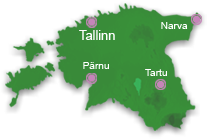| Companies | Tourist Attractions & Sightseeing | Map Search |
Rotermann City as a Model of the Modern Urban Environment14.August 2015
Rotermann first appeared on the city map in 1829 when industrialist Christian Abraham Rotermann established the first trade market, and then a complex of factories next to the Old Town. The next generation of entrepreneurs expanded the enterprise as the area became a centre of technical progress and manufacturing in the region. At its peak, Rotermann had a metal workshop, a car dealership, a bakery, a department store, a salt cellar, building materials warehouses and timber, spirits, wool- and grain yards. In the 20th Century manufacturing in the quarter declined. However the quarter gained fame as the setting for Andrei Tarkovsky's 1979 science fiction classic, “Stalker”. Nonetheless by the end of the Soviet era, the quarter had gone into decline and continued to be in a decrepit state for most of the 1990s. In 2001, the National Heritage Board recognised the valuable historical atmosphere of the complex and the last decade has seen the quarter rejuvenated as a prime commercial and residential quarter, a few steps from the Medieval Old Town. Today, the architecturally celebrated, Rotermann City is one of the most exclusive residential and commercial areas in Tallinn, offering a self contained, secure, and vital environment in which to live and work.
Tõnis Sõõrumaa, a member of Rotermann City Management Board takes up the story. “Other cities have similar projects, but only Tallinn has this kind of quarter in the city centre,”Sõõrumaa said. “Its location has great advantages. Being next to the Old Town, tourists can easily visit it.”
Pedestrian Oasis Yet as Sõõrumaa explains that location is not the only key to Rotermann's success. “One of the key facts of the project is that we are developing it as a whole. The heart of the project is a great fundamental concept. Car-free streets are paramount. “This kind of pedestrian oasis in the city centre is an unimaginable luxury for a city. We pay a high price for it, as we have to think constantly about logistics, but it is worth doing,” Sõõrumaa said. Car-free streets create a distinctive environment for both tourists and citizens. Restaurants and shops occupy the lower storeys of the buildings, while apartments and offices the upper storeys. At present, 1,200 residents live in the quarter. There is such a demand for office space that it is over subscribed. “The offices of the best lawyers and notaries are located here. Advertising companies also love the quarter. We considered the Old Town as our competitor at the beginning. However, shopping in the Old Town has vanished. We have created an environment where shopping is leisure. And our prices for offices and shops are lower than those in the Old Town,” Sõõrumaa said. And that is not all, Sõõrumaa explains that the terraced roofs, and summer events are helping to build a community spirit. “Isn’t it wonderful the residents of the quarter spend no time getting to their jobs, and their children can spend evenings outdoors without being afraid of cars?” he said.
What does the future bring? Chimney stack to be preserved
The quarter comprises 70,000 square metres. At the moment, 40,000 square metres are occupied. There is currently construction works involving several historical buildings. The land where the former boiler house stands is being repair, and the 53-metre smokestack will stand to commemorate the industrial past of the legendary quarter.
Fresh Bakery
Dining out in Rotermann offers quality and variety, popular both with locals and tourists. There are several excellent options for fine dining. Outstanding examples include the international cuisine of Platz Mediterranean andthe Spanish cuisine of Alter Ego,and the Indian cuisine of Bollywood.l Carmen Cafe is a perfect place for having a delicious and filling breakfast or lunch. It is also great for young mums to have a cup of coffee and slice of cake while the little ones enjoy their day time nap in the pram.
Meanwhile the former grain elevator on Ahtri street will house a butchers. As Sõõrumaa explains currently locals use Central Market to buy fresh meat, there'sg no high-quality butchers in the city centre. “Meat will be delivered in the morning, processed, and carved openly behind a screen so that everyone will be able to choose the piece they want,” Sõõrumaa said adding that he is confident 50% of the restaurants in Tallinn will get their fresh meat from here. The delicate aroma of fresh baked goods will also bring life to the old factory complex starting from next year. “We will turn ventilator outdoors that's for sure,” Tõnis Sõõrumaa said with a smile.
All the first floors in Rotermann will have exciting and well-planned stores. Since the quarter is focused on the younger generation, there will also be some popular fast-fashion brands available. The upper floors will have 89 apartments and multiple offices.
Rotermann City is an evolving and vibrant example of an urban environment where you can enjoy modernity in an historic setting.
|




)
